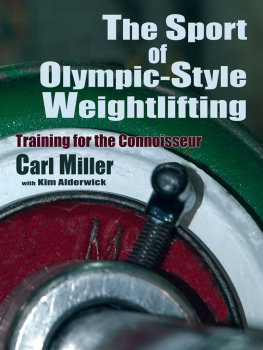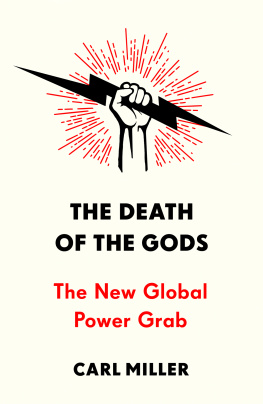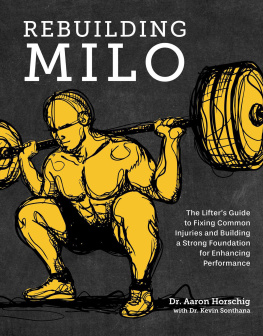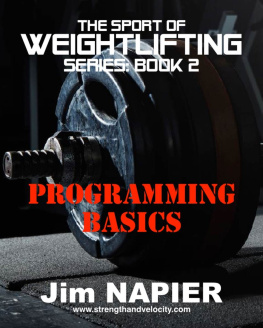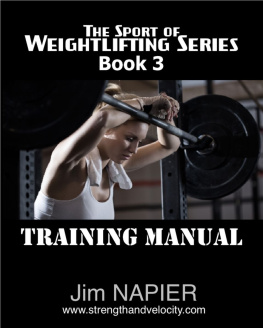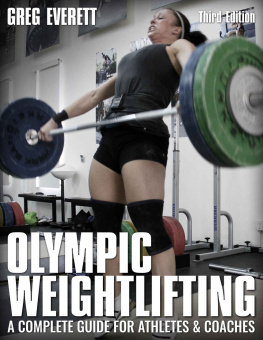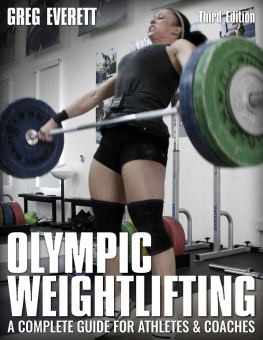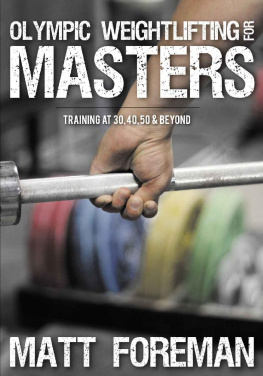
Praise for Carl Miller

A fter reading Carls The Sport of Olympic-Style Weightlifting: Training for the Connoisseur, Im amazed at his insight and ease of expressing to all the secret and analyzing process that all serious weightlifters would give their eyeteeth to learn. This is the most comprehensive treatise that any weightlifter could hope for. During my years of training, I would have welcomed such great information. When reading this book, pay special attention to the detail that Carl expresses to each of you, because of the different structure we each have. He gives me the desire to start lifting again. Anyway, this is a must have detailed book for all serious weightlifters.
Frank Spellman, former US National and Olympic Weightlifting Champion
I met Carl Miller in 1975 as an aspiring Class 1 Lifter. Five years later, I qualified for the Olympic Team at 90 kg. I can honestly say without Carls expertise, guidance and encouragement, this would never have happened. This book is a compilation of proven training techniques that can help any lifter, no matter what level, to stay strong, flexible and functional into their 80s and beyond. As a successful Physical Therapist of 34 years, Ive learned from Carl, and I pass this on to my patients to stay strong and enjoy Life!
Luke Klaja, Physical Therapist,
1980 US Olympic Weightlifting Team, Masters National Record
V irtually all physicians consider regular exercise to be a crucial component of good health. Carl Miller has drawn on his background in physiology and his lifetime of experience in developing these exercise programs that are good from beginners to international competitors. The book he has written is extremely well thought out, thorough, detailed, and sensible. I highly recommend Carls book and program to all people interested in this style of exercise.
Robert M. Bernstein, MD, FACE
.
Many weightlifters never understand or discover the tricks to proper peaking, which Carl explains with ease in . This book is a wealth of information not only for the novice weightlifter, but for the experienced, competition tested weightlifter as well.
I thoroughly enjoyed the Introduction on Carl Millers education and experience. It sheds light on how Carl trained to compete and how he trained his athletes to compete and why both he and his athletes were and are so successful. It is always fun and educational to read about and learn from athletes of the past. With the scientific advances since those times, there is no reason that we shouldnt be #1 in the World in Olympic weightlifting and this book may be the catalyst to effect that change. Great job Carltwo thumbs up!
Doug Briggs, PhD, CSCS. Director of Human Performance-US Army/MWR, two-time
Masters Pan-American Champion and two-time Masters National ChampionUSAW. Author of Built for Strength: A Basic Approach to Weight Training Success for Men and Women

2011 by Carl Miller.
All Rights Reserved.
No part of this book may be reproduced in any form or by any electronic or mechanical means including information storage and retrieval systems without permission in writing from the publisher, except by a reviewer who may quote brief passages in a review.
Sunstone books may be purchased for educational, business, or sales promotional use.
For information please write: Special Markets Department, Sunstone Press,
P.O. Box 2321, Santa Fe, New Mexico 87504-2321.
Book and Cover design Vicki Ahl
Body typeface Myraid Pro
Printed on acid free paper
Library of Congress Cataloging-in-Publication Data
Miller, Carl, 1940
The sport of Olympic-style weightlifting : training for the connoisseur / by Carl Miller with Kim Alderwick
p. cm.
ISBN 978-0-86534-811-0 (softcover : alk. paper)
ISBN 978-1-61139-084-1 (e book)
1. Weight lifting. I. Alderwick, Kim. II. Title.
GV546.3.M55 2011
796.41--dc22
2011008346

WWW.SUNSTONEPRESS.COM
SUNSTONE PRESS / POST OFFICE BOX 2321 / SANTA FE, NM 87504-2321 /USA
(505) 988-4418 / ORDERS ONLY (800) 243-5644 / FAX (505) 988-1025

Contents

Preface

M any lifters do not achieve their goals because to get to the top, you have to be a real connoisseur.
Many lifters do not know what they want to do.
If they know what to do, they do not know how to do it.
If they know how to do it, they do not want to work hard enough to achieve it.
If they work hard enough, they do not know how to eliminate the errors and omissions.
Do not be afraid of getting to the top because once you get there, you have less competition. Everybody else has eliminated themselves. They have found their niche.
Carl Miller
Acknowledgments

T o Kim Alderwick who did the vast majority of editing to the manuscript.
To Jan Orcutt who greatly helped in the final editing.
To Shane Miller for content advice.
And to all the fine coaches and athletes I came in contact with.
Introduction by Kim Alderwick

O lympic lifting may be one of the purest of all sports. It distills the quickness, agility, power and coordination essential to all athletic endeavors into a single, brief motion. It truly is a sport for connoisseurs. Theres nothing like it.
True story. I was interviewing Carl Miller in the main office of his gym when a man came to the door. Carl Miller? I just moved back to town, and saw you still had a gym here. I want to thank you. I was in your gym class at Carlos Gilbert Elementary, 30 years ago, and you changed my life. The universe sure has a way of punctuating a moment.
Carl and I had been talking about his life and work, and this interruption was perfectly timed. In a few words, this man summed up why Miller and I had been talking at all. His contributions to the field of Olympic weightlifting have been enormous, and his influence within the field of fitness has been equally so.
Miller was first introduced to weightlifting by his stepfather, Leonard McRae. McRae almost lost his leg in World War II and was told to exercise to maintain the function of his knee. He worked out regularly and sometimes he brought his 12-year-old stepson with him. One day, McRae took the boy to a gym in Hollywood. Not just any gym, it was Bert Goodrichs chrome-and-leatherette-appointed Gym to the Stars.

